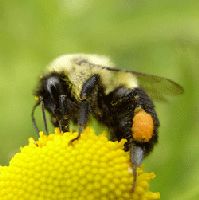
|
Some Common Myths Thought to be True - Myth 51
Myth 51: Bumblebee Should Not be Able to Fly
According to 20th century folklore, the laws of aerodynamics prove that the
bumblebee should be incapable of flight, as it does not have the capacity (in
terms of wing size or beats per second) to achieve flight with the degree of
wing loading necessary. The origin of this claim has been difficult to pin down
with any certainty.
|
| A Bumblebee | |
|
The calculations that purported to show that bumblebees cannot fly are based
upon a simplified linear treatment of oscillating aerofoils. The method assumes
small amplitude oscillations without flow separation. This ignores the effect
of dynamic stall, an airflow separation inducing a large vortex above the wing,
which briefly produces several times the lift of the aerofoil in regular
flight. More sophisticated aerodynamic analysis shows that the bumblebee can
fly because its wings encounter dynamic stall in every oscillation cycle.
|
|
| ⇦ Back to Myth 50 Return to Myth Choices Page 4 On to Myth 52 ⇨ | |